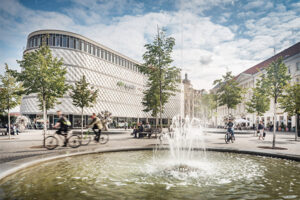By Nelson Blackley
While there was steady growth in online retail sales from 2012 to 2017, although it varied between different countries, it only represented 12% of Europe’s 2017 total retail sales; so, it is clear that the promised online “takeover” of retail is unlikely to happen any time soon.
However, an unexpected trend has also emerged over the past few years, both in Europe and in other parts of the world, with online retailers and brands now moving “offline” and opening stores (“clicks to bricks”). Even Amazon now operates over 600 physical retail venues around the world. Other examples include:
Bonobos, launched in the USA as an exclusively online fashion retailer in 2007, started opening physical showrooms in 2012 for shoppers to try on product, but without the need to stock excessive inventory in stores.
Zalando, the Berlin-based online fashion retailer, which operates in 17 European countries, currently has stores in Frankfurt, Cologne, Leipzig, and Hamburg and opened its first beauty store in Berlin in July. Its CEO has also indicated that the company is looking to open a limited chain of flagship stores focused on other large cities like Paris and London.
Warby Parker, the eyewear brand, was one of the first to understand the complementarity of digital and physical shopping. Its first store opened in 2013, and, by the end of 2018, it counted 100 stores across the US and Canada. Half of its revenues now come from its physical stores.
Missguided, the UK own-brand womenswear retailer, also began purely online, gathering a huge social media presence among its target 16-34 age group. It now has two stores in shopping centers in East London and Kent as well as concessions in Selfridges stores in Birmingham and Manchester. These are designed to be deconstructed versions of the Missguided website.
These, and other online retailers, are strategically using their newly acquired physical space to complement rather than compete with their online operations and have a clear view of the role stores play within their channel “mix”. There is also evidence, from the recent International Council of Shopping Centers report, that “The Halo Effect” caused by the opening of a physical store drives up the retailer’s share of web traffic within that market by an average of 27%.
With extensive consumer databases accessible through their catalogues and/or online operations, and integrated data processing systems, retailers moving from “clicks to bricks” also benefit from unique insights. They have in-depth and personal understanding of the changing demands and behaviors of their consumers, which helps ensure decisions about opening stores are both customer-focused and market-driven. They also recognize that a physical presence offers consumers different benefits and can be used to reinforce a consistent brand image, as well as broaden the appeal of their brand.
Stores have the potential to engage customers’ five senses by demonstrating what brands look, sound, smell, feel, and even taste like. Finally, fulfilling customer orders is one of their biggest outgoing costs, so the move from “clicks to bricks” can give online retailers a more efficient way of getting purchases to customers, simplifying and making the “final mile” more cost effective.
Sign up for our ACROSS Newsletter. Subscribe to ACROSS Magazine.





